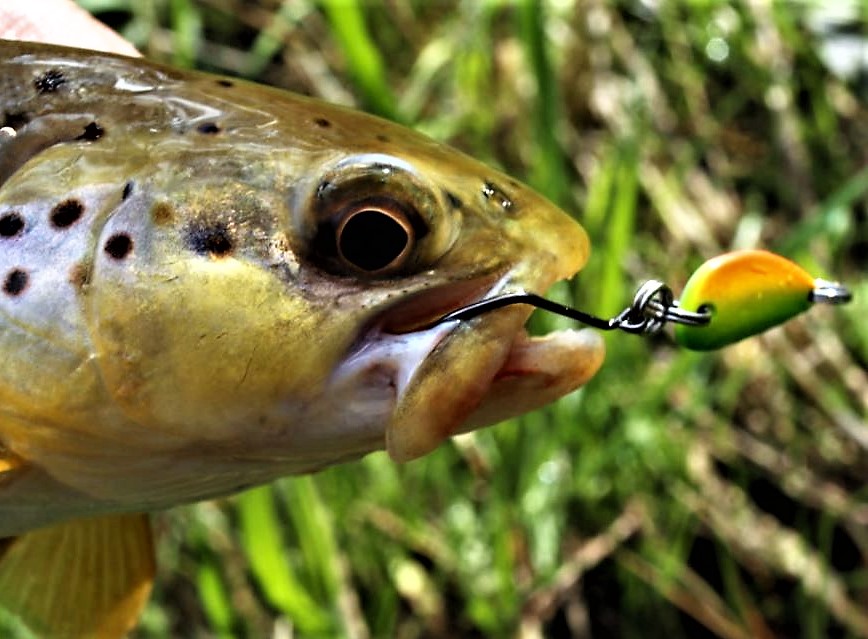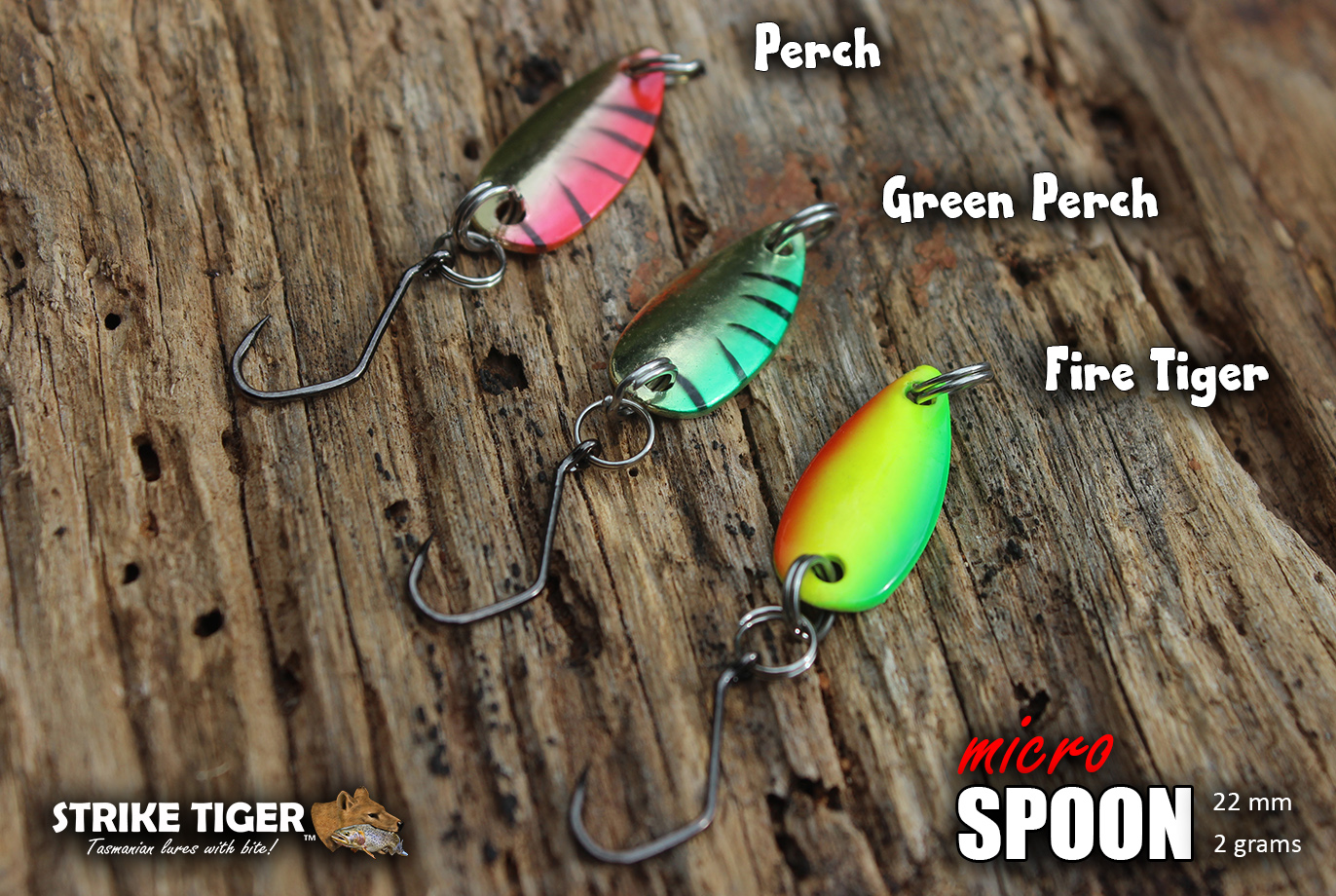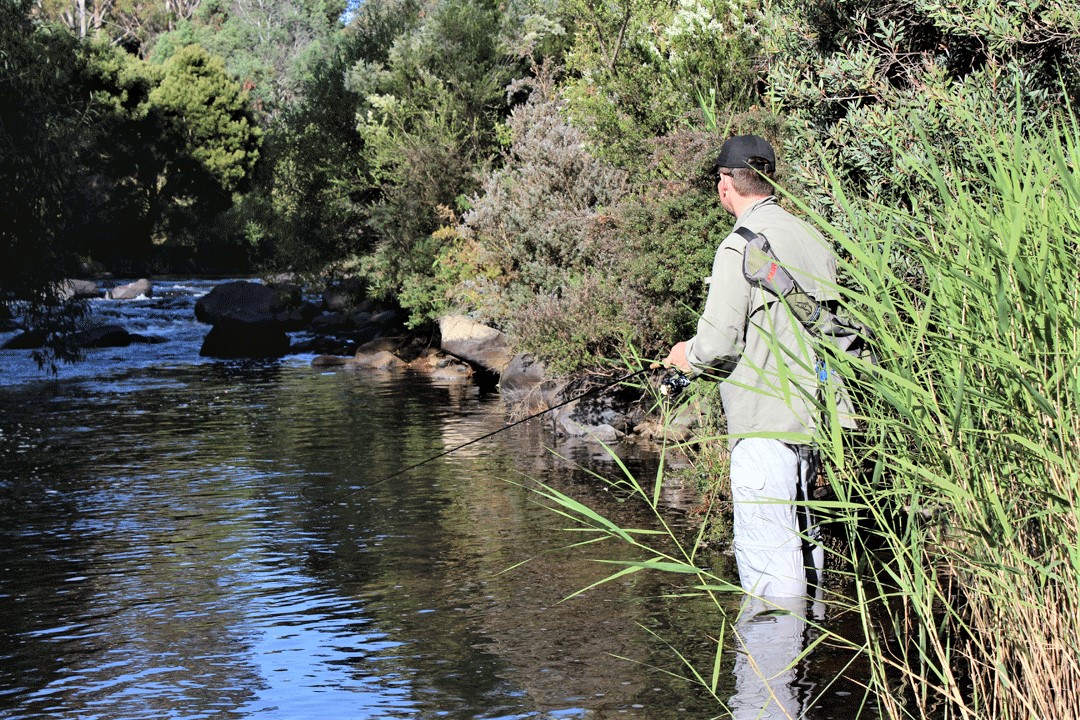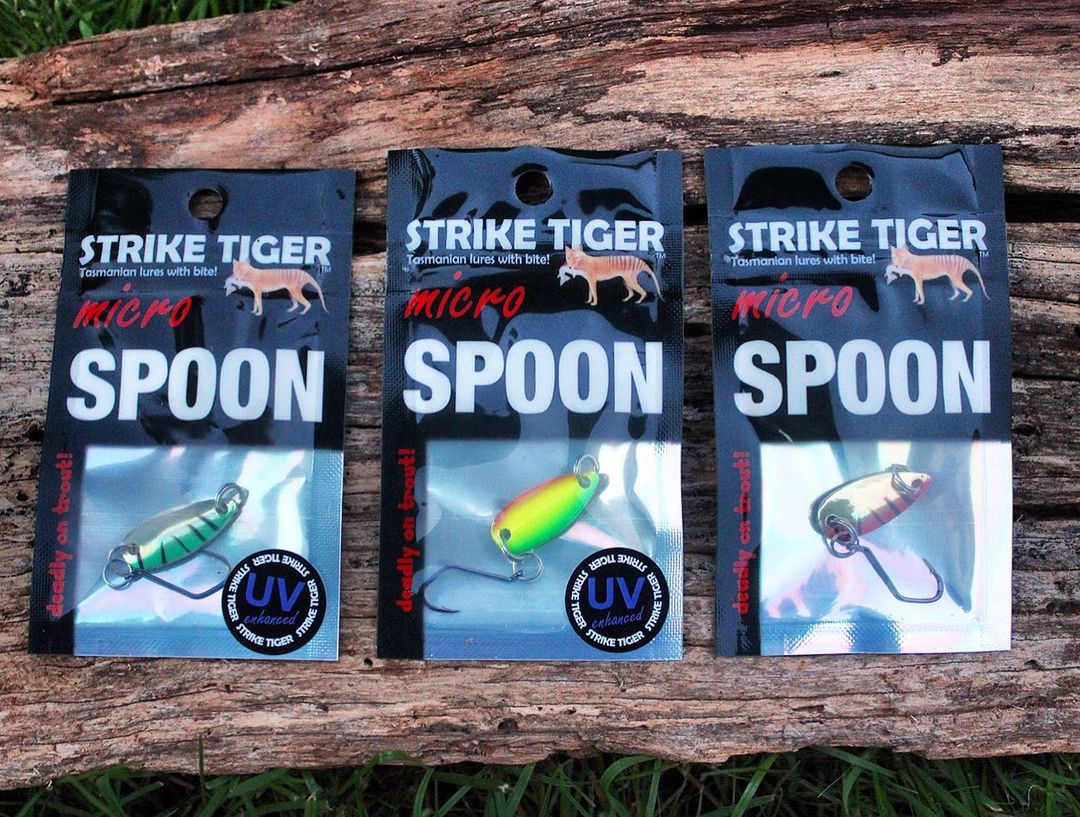
Introduction
Fishing for wild trout in a small river, creek or stream can be a wonderful experience. For me, it is not always about catching the ‘big one’. The trout found in such waters are usually very small, with fish around 15 to 20 cm in length and around 200 grams in weight being very common. Although these fish are small, they have some of the most beautiful markings you will ever see! These unique markings are what set them apart from your standard lake or larger river specimens.
Despite their small size, trout like this can still be a handful on light gear and this is what makes fishing for them a very enjoyable experience. These little pocket rockets have a huge following in North East Victoria, the Snowy Mountains region of NSW and also in many parts of Tasmania. And it is no wonder given that these parts of Australia have some of the best trout fishing in the country!
The keen trout angler will no doubt be familiar with the style of fishing typical in smaller rivers and streams. Such places can be hard to access by foot and can be even trickier to fish. The depth of the water is probably to biggest influencing factor on how you choose to fish. Lures that you enjoy using in deeper lakes and rivers will generally not perform well in shallower skinny waters.
Trout often need adequate time to see an offering and, it is for this reason, that heavier lures will not be effective. In knee-deep water, your lure will end up sinking and snagging up on the bottom before you know it. This leaves little or no chance for trout to see what you have on offer. There is also the other issue of the actual size of the lure. You don’t have to be a rocket scientist to figure out that small trout won’t swallow large lures easily. In other words, the lure that you choose needs to be small enough to fit inside their tiny little mouths.
If you are into ‘catch and release’, then this is also very important. Larger lures, such as hard bodies fitted with treble hooks, will often damage these smaller trout. In my experience, the rear trebles often penetrate the body of small trout, with most of the damage being done during the removal of the hooks. While you may still be able to release the fish, it is likely to have a somewhat reduced chance of survival.
If you do not practice ‘catch and release’, this is still an important consideration. You have to remember that a lot of these trout are undersize and you will be legally required to release them. In Tasmania, the general legal length for brown trout is 220 mm or 22 cm. There are a lot of smaller specimens getting about out there that are still very keen to have a go at your lure!
So what is the best option for you? Well you could use a floating hard body lure, retro-fitted with single hooks, or even a micro-sized soft plastic. But there is still yet another option. Let me introduce the Strike Tiger micro spoon fishing lure...
The Strike Tiger micro spoon
A ‘micro spoon’ is exactly as it name suggests - it is basically a tiny version of the standard casting spoon commonly found on tackle store shelves. Casting spoons were once a very popular item in Australia. As a child growing up in Tasmania in the 1980s, I recall them being a popular item for anglers chasing trout in the central highlands.
The spoon that I am referring to was a heavy lure, which made it easy to cast. Best of all, it required no special skill to use. Tied on to some mono and cast out by even a young novice like myself was often all that was required to produce good results. The combination of colour and the simple built-in ‘wobble’ that metal casting spoons have seemed to be the two secrets to attracting fish – namely trout. Although hard body lures and soft plastics have taken over a large proportion of the market in Australia today, spoons are still available.
In contrast to a normal casting spoon, which usually weighs around 7 grams and is around 50 or 60 mm in length, the micro spoon typically weighs around 2 grams and is only around 20 mm in length at most. Because of the tiny size and weight, the micro spoon is well suited to shallow river and stream fishing for small wild trout.
Usually fitted with a smaller single hook, the micro spoon enables better hook-ups on smaller trout, plus it provides easy ‘catch and release’ with minimal damage to the fish. I sometimes even clamp the barbs down on the hooks to decrease the damage – something to think about if fishing in Tasmania’s National Parks or World Heritage Areas. Besides this, the other advantage of the single hook setup is increased snag resistance over areas that have a rocky bottom or weed.
Colour selection
Most of you know that colour can be the single most influential factor in catching trout. Just like fly fishing or fishing with soft plastics, it is important to find out what natural food sources the trout are feeding on.
Although a micro spoon does not resemble the shape of many food sources (apart from perhaps a minnow or fry due to the ‘wobbling’ action), the colour of your spoon can be matched to a particular food source. For instance, if there are redfin perch in the waterway, trout will often feed on the tiny juveniles. Using a micro spoon that is painted with a redfin perch pattern that imitates this food source would therefore be a wise choice.
Other micro spoon patterns rely on ‘bite triggering combinations’ rather than on imitating specific food colours. The behaviour that I am referring to here is what is sometimes called a ‘reaction bite’. To put it simply, trout will strike at a particular colour out of nothing more than pure aggression. Lure action can also induce a ‘reaction bite’. When a trout’s personal territory is invaded, they will strike in order to remove the threat. Some well-known examples of bite triggering colour combinations include black and gold, black and red, green and gold, fluoro green, orange and yellow just to name a few.
Micro spoon selection

Gear selection & setup
A fairly stiff, but very light-weight spinning rod is what I recommend. A little river rod that is rated around the 2 kg mark is ideal in my opinion. The length of the rod need not be more than six feet – you are not casting for miles in the waterways that you are likely to be targeting. Most of you will have something that is suitable in your fishing arsenal. If not, I am sure that your local tackle store will be more than happy to point you in the right direction!
Choose a good-quality spinning reel to match your rod. I would recommend a reel size of 1500, and no greater than 2000. Probably the best indicator of what setup is best, is to just pick up your rod, with reel attached, and see how it feels. It should be nicely balanced. Try it - you will soon know if it feels right!
Because we are fishing micro sized spoons of only around 2 grams, it is important to match your main line and leader accordingly. In my opinion, a 3 to 4 lb braided main line, matched with the same size fluorocarbon leader is the perfect setup. Use around a rod length of leader for best results. The setup is much the same as the one commonly used on larger Tasmanian lake trout – only much lighter. Use something like a ‘surgeons knot’ or a ‘double-uni knot’ to join your mainline to your leader.
Strike Tiger micro spoons come with a split ring for attachment to your leader. To do this, use a knot that you are comfortable tying and, more importantly, trust. For many people, this can be as simple as the common ‘blood knot’ – very easy!
The setup that I have described will enable you to cast that micro spoon for maximum distance. The key thing to remember here is that the finer your line, the further you will cast. It is also a major bonus when tackling wild river trout that are often easily spooked by heavier setups.
Where to find trout

The first thing that I will say here is that you can’t catch a trout that isn’t there! It is so obvious that I hate to say it, but nothing is more important than fishing where the fish are. Finding the fish usually involves reading the water. In clearer water, you can often see the trout, enabling you to cast at them – this is commonly referred to as sight fishing. But when you can’t see them, what do you do?
My answer is to look for anything that may break the current flow. Trout love to lie in areas of ‘slack’ water in wait for any food that might be travelling past. By keeping themselves out of the current, they are also able to conserve their energy.
Look for obvious things such as protruding rocks or boulders, or even logs, which all provide good breaks in the current flow. You should also consider what lies under the water that might be breaking the flow. The trick here, given that you can’t always see these obstacles, is to try to read the surface of the water for clues.
This takes a bit of experience to master, but in general, the water surface will take on a different appearance. You need to look for areas of water that have a different ‘surface pattern’ to the rest of the river, creek or stream.
Strike Tiger micro spoon techniques
The main consideration when using a micro spoon is to slow your retrieve right down. The spoon should 'wobble' from side to side when you retrieve it. These are not spinners. So if you see it spinning, you are retrieving too fast!
Targeting slack water/obstacles
Before fishing any river, creek or stream, have a look for key features that might be ‘holding places’ for trout. That big boulder or fallen tree might just be the spot to target with your new micro spoon setup. Although this is a starting point, there is actually a great deal more to reading water. Entire books have been written on the subject and, even then, the authors sometimes fail to cover all of the possible considerations. I think this is what actually makes this type of trout fishing such an unpredictable but exciting sport!
Cast upstream at your chosen obstacle or area of slack water. If the area that you are fishing is ‘knee-deep’ or similar, start retrieving straight away. A simple flat retrieve is a good one to use here. Just wind back slowly and constantly – nothing special required. The thing that I will stress is that if you retrieve too fast, the micro spoon will ‘spin’ much like a bladed spinner and you will end up with twisted line. Aim at retrieving the spoon just fast enough for it to wobble from side to side. A good idea is to test it beforehand so that you get the feel for the correct speed.
Your spoon will occasionally come into contact with underwater rocks, which can feel like a legitimate strike. I haven’t come up with a solution for this yet, but all I can say is that it is better to try to set the hook than not. Missed takes can result if you don’t. Sadly, snags are sometimes a common outcome too!
Drifting a micro spoon
The following technique is a little bit unorthodox to many, but I guarantee that it works. It simply involves casting upstream and letting your micro spoon ‘drift’ back to you. For this to be effective, firstly you need substantial current flow to carry the spoon. You will find that it will ‘flutter’ erratically as its carried down-stream. From my own experience, trout seem to love this type of action!
The second thing that is very important with this technique is to keep your line tension tight enough so that you can feel any takes. This is sometimes easier said than done and I rely more on watching what the line is doing on the water rather than on what it may feel like. Learn to look for any movement in that main line and you will soon be catching trout like a champion!
Covering an area
This is a great technique to cover a larger body of water or when you are unable to locate any of those trout holding features that I described earlier. Start off by locating a spot where you can walk upstream easily, where there are not too many obstacles, like overgrown riverbanks, trees or fallen logs. Cast your micro spoon upstream at 45° into the current flow of the river. Aim to land the spoon as close to the opposite bank as possible. Use the flat retrieve that I described earlier to get it back in.
Your next cast should be on the same trajectory, but you should aim to land that spoon slightly closer to where you are standing. Again, use the same flat retrieve. Keep decreasing the distance of your casts as you progress. By doing this, you will cover an entire area quickly and effectively. If you don’t catch anything, keep moving upstream and cover the next section using the same technique.
Conclusion

Spoons have been around for years and have been responsible for many trout catches all over the world. Even though the Strike Tiger micro spoon can seem simple compared to the current style of fishing lures, I am confident that the attitude of trout to spoons remains the same as it has always been! With so many different soft plastic and hard body lure designs available, we sometimes forget that using something simple and different might be all we need to improve our catch rate.
